Bioengineering Design-a-thon Gives Students a Head Start in Designing Medical Products
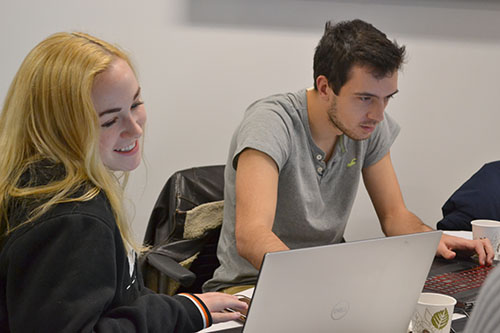
Bioengineering students learn how to use Autodesk Fusion 360 while participating in BioE's Design-a-thon.
November 25, 2019
Bioengineering students who dream of designing medical products in the future got a taste of what it’s like during Bioengineering’s recent Design-a-thon on Friday–Saturday, November 8th–9th. Winners received prizes that anyone would love with the holidays looming: Amazon gift cards. However, while winning a prize was obviously an incentive, many students actually got involved for the design thinking training and to gain expertise in 3D CAD (computer-aided design), specifically Autodesk Fusion 360. Of course, for some, the main incentive was the thrill of competition.
The Bioengineering Design-a-thon was sponsored by several organizations from both campus and industry. In addition to the Department of Bioengineering (BioE), sponsors included a new campus RSO: I-MADE (Illinois Medical Advancements Through Design and Engineering). Other sponsors included Autodesk, which sent an expert to train students in Fusion; Enduvo, a delivery platform for training in the healthcare industry, and the Society for Simulation in Healthcare, which advocates using simulation to improve performance and reduce errors in patient care.
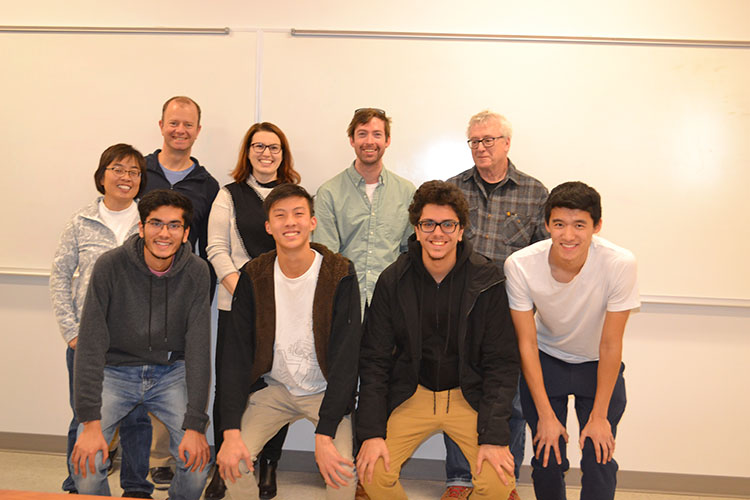
Front row: first place "We Kneed Money," team. Second row: Liz Hsiao-Wecksler,Mechanical Science and Engineering Professor; Paul Pribaz from Business Development at Enduvo; Jenny Amos, BioE Teaching Associate Professor; Eliot Bethke, Idea Project Coordinator in the Carle Illinois College of Medicine; and David Weightman, a professor in the School of Art and Design.
Teams of between two to four students had less than 24 hours to design medical products based on a prompt that was revealed at the kickoff. As one might guess, in light of some of the clever titles students came up with for their presentations, including “Clinical Kneeds,” “TrainKnee,” and “We Kneed Money,” products were to address...the knee, specifically devices that would enable medical students to learn how to diagnose knee injuries. So the products the Design-a-thon participants were to design were to facilitate training about diagnosing or treating an ACL or meniscus tear or other knee-related injury, including resources that would eclipse current knee-related diagnoses, such as the McMurray, Anterior Drawer, or Lachman tests.
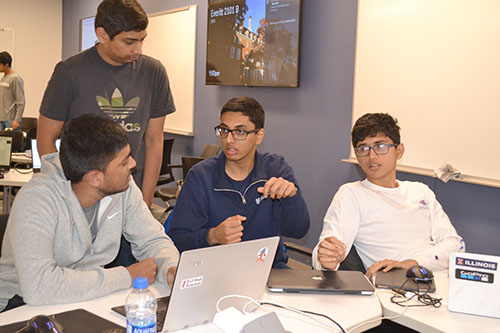
Bioengineering students discuss the product they're designing during BioE's Design-a-thon.
The event began Friday evening the 8th with training in design thinking and Autodesk Fusion 360. Given the short turnaround, teams’ first deliverables were due by 11:00 pm that night; their finished product was to be submitted by 11:00 AM the next morning. Each team then presented their designs to a panel of judges: Liz Hsiao-Wecksler, a Mechanical Science and Engineering professor and BioE affiliate; Eliot Bethke, Idea Project Coordinator in the Carle Illinois College of Medicine, and David Weightman, a professor in the School of Art and Design.
After the presentations, the judges deliberated briefly, then announced the winners, who received their prizes: Amazon gift cards worth $400, $300, and $200 for first, second, and third place winners, respectively. The first-place winner was the “We Kneed Money” team; second-place winner was “JAM: A Knee Training Model”; the third-place winner was GenuSim.
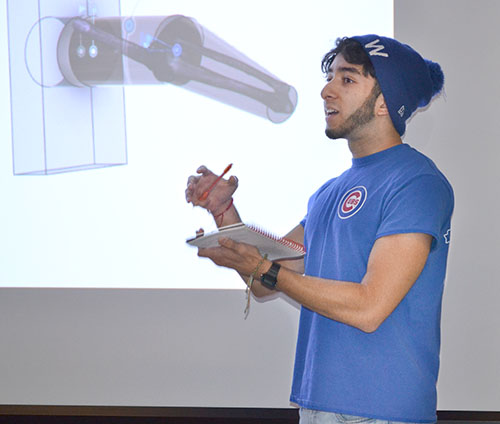 Oscar Coronel presents the TrainKnee product he and Ashley Mitchell designed.
Oscar Coronel presents the TrainKnee product he and Ashley Mitchell designed. 
Bioengineering seniors Oscar Coronel and Ashley Mitchell design their product during BioE's Design-a-thon.
While the prize was a nice incentive, most students actually got involved with the Design-a-thon for the bioengineering experience it gave them. For instance, BioE senior Oscar Coronel shares why he participated. “I think designing products with CAD has always been an interest of mine,” he admits. “So it's something I've always wanted to practice, and I thought this was a good experience to do so.” While he had taken a course using Autodesk Inventor a couple of years ago, he acknowledges, “I didn't remember much, so it was a good refresher.” Regarding Autodesk’s Fusion 360, he adds, “I think I definitely want to practice it more. It looked like a really cool application.”
Another Design-a-thon participant, his teammate Ashley Mitchell, also a BioE senior, says she too got involved for the CAD training. “I was really excited for the Design-a-thon because what I want to go into is product development,” she shares. “So, being a bioengineering major, this was perfect for being in the medical industry.” Mitchell particularly appreciated both getting the project experience and also learning a new software which she hadn’t used before.
Regarding the engineering as well as the biology training she’s receiving in BioE, she says “It's definitely a combination of the mechanical side, but then also recognizing that you're dealing with people, right, so you have to understand that system.”
A member of the JAM team (an acronym made from the team members’ first names), BioE junior Joy Chen did the Design-a-thon because she’s really interested in medical innovations and medical devices. “It was a fun challenge to do,” she admits, and I knew that it was going to be in CAD, and I don't actually have that much CADDING modeling experience. So I came here to kind of learn how to do that and then create a project out of it.”
Chen's teammate, Anna Busza, another junior in Bioengineering, shares how she benefitted through the competition. “I learned tons of CAD. So I don't know when the next time I'll use CAD will be, but I'm thinking at least it'd be applicable to other designing platforms, hopefully.” For example, Busza figures it might come in handy in her BioE senior design project down the road.
Busza’s dream job is to be a medical practitioner, and she believes her BioE experience will help her to more clearly see and meet her patients’ needs.
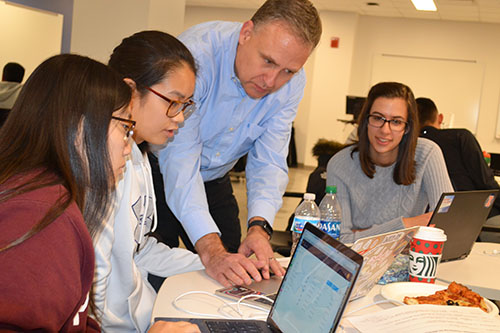
The Autodesk instructor teaching the session on Fusion 365 helps the JAM team members with the software during the BioE Design-a-thon training session.
“I feel that, for me, is the big thing. It's seeing the issues and thinking of how they can be solved…just seeing that interface.”
While she’s not sure if she will be the one doing the designing, she hopes knowing how BioE product design works will give her “a better idea of how to approach problems in the future and seeing what different problems would be and how we could solve them, or potential solutions, or what the possibilities are within a reasonable range.
The third member of the JAM team was Mia Ko, also a Bioengineering junior. Regarding her dream job, she says “I hope to land somewhere in industry working with pharmaceuticals and drug delivery systems—so finding more cost effective ways and less toxic or painful ways to deliver drugs to patients.”
Regarding why she took part in the Design-a-thon, Ko admits, “I have zero CAD experience, and I'm actually not a very visual 3D model kind of learner.” So her goal in participating was to get “kind of a taste.”
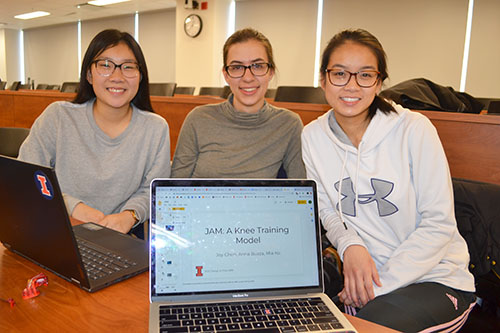
Bioengineering juniors Mia Ko, Anna Busza, and Joy Chen wait to see if they won a prize in the Design-a-thon for their Knee Training Model.
“I hope to be able to expand my knowledge into more interdisciplinary, and to be able to see how the things that I want to do are implemented in an actual model, and how you actually build those models—being able to just see that correlation, that relationship. This is kind of an intro to that.”
How does Ko think their product turned out? I'm actually wildly impressed by what we did,” she says, adding, “We're not the best modelers.”
So, did she think her team would win? She confessed that she wasn’t sure, given that there were a lot of great ideas. “But the fact that we considered not only the anatomical features of the knee, but also trying to consider our limited knowledge of mechanics and being able to combine all that, I think we did a solid job.” The judges agreed, giving her team second place!)
Story and photos by Elizabeth Innes, Communications Specialist, I-STEM Education Initiative
For more related stories, see: Bioengineering, Undergraduate, 2019
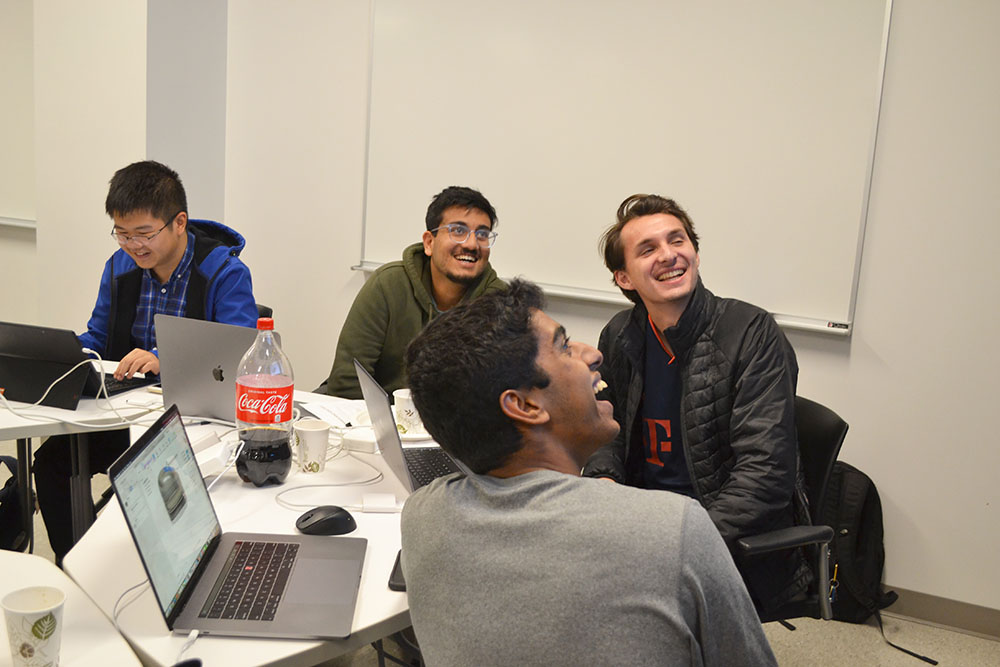
GenuSim team members enjoy the Autodesk Fusion 360 training. The GenuSim team won third place.













.jpg)
















